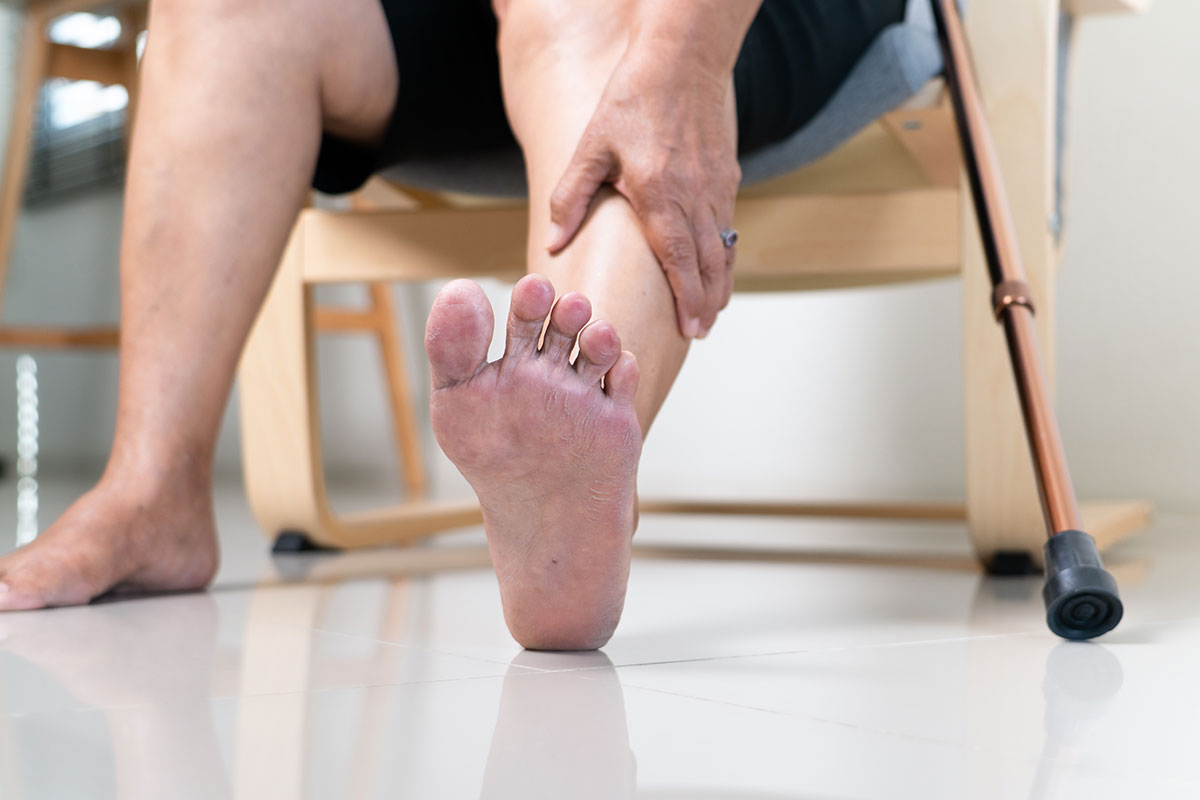Diabetic Neuropathy and Foot Pain: Protect Your Feet
Peripheral neuropathy caused by diabetes is often referred to as diabetic neuropathy. According to the CDC, over 9% of the US population has diabetes, and an estimated 30-50% of those patients will eventually develop neuropathy. But what exactly is diabetic neuropathy? Simply put, it's nerve damage caused by long-term high blood sugar levels. Over time, poorly controlled blood sugar can injure the nerves throughout a person's body. While it can affect various parts of the body, it most often impacts the legs and feet.
If you're experiencing diabetic neuropathy, then you might not feel pain in your feet, even if you have a blister, cut, or other injury. Think of your nerves as messengers: when they’re damaged, the messages don't get through properly. That’s why you might step on something sharp and not feel it, or develop a sore that goes unnoticed for days.

Why does diabetic neuropathy happen?
When your blood sugar levels are high over a long period, it can damage the small blood vessels that supply oxygen and nutrients to your nerves. Without enough oxygen, the nerves begin to malfunction.
Risk factors that increase your risk of developing diabetic neuropathy include:
-
Uncontrolled blood sugar levels: High blood sugar over time is the main cause of nerve damage.
-
Long duration of diabetes: The longer you’ve had diabetes, the greater your risk.
-
High blood pressure and cholesterol: These can contribute to blood vessel damage.
-
Smoking: Smoking reduces blood flow to your extremities, further harming nerves.
How does diabetic neuropathy affect your feet?
Neuropathy can lead to a wide range of symptoms in your feet. If you have diabetes, it's very important to take any of these symptoms seriously and make an appointment with your doctor.
Numbness or Reduced Sensation
One of the most concerning aspects of diabetic neuropathy is that it can make your feet feel numb or tingly, often starting at the toes and spreading upward. You may lose the ability to feel temperature changes, pressure, or even pain. This means small injuries like cuts, blisters, or sores may go unnoticed.
Pain and Burning Sensation
While some people experience numbness, others may feel the opposite—a burning or sharp pain, even without an injury. This pain is usually worse at night and can make it difficult to sleep. It’s a sign that your nerves are being damaged.
Muscle Weakness
Nerve damage can weaken the muscles in your feet, leading to problems with balance and coordination. This can make you more likely to stumble or fall, further increasing the risk of injury.
Changes in Foot Shape
Over time, nerve damage can lead to changes in the structure of your feet. Conditions like hammer toes, flat feet, or Charcot foot (a rare but serious deformity) can develop due to muscle imbalances and poor joint alignment.
Why is not feeling foot pain dangerous?
You might think not feeling pain sounds like a good thing—after all, who likes pain? But in reality, pain serves an important purpose. It’s your body’s way of letting you know something is wrong so you can address the problem. Without pain, you may not realize when you’ve stepped on something sharp, developed a blister, or have an infection brewing.
If you don’t feel the pain from a small injury, you might not take care of it right away. What could have been a minor issue can become a serious problem over time. In people with diabetes, even a tiny cut can lead to diabetic foot complications such as:
-
Foot ulcers: Open sores that are slow to heal. Without proper treatment, they can become infected.
-
Infections: Without pain to alert you, an infection can spread quickly, affecting deeper tissues and even bones.
-
Gangrene: When tissue dies due to a lack of blood flow, leading to blackened skin and, in severe cases, the need for amputation.
What are the best ways to protect your feet?
The good news is that you can take steps to protect your feet, even if you have diabetic neuropathy. Prevention is key, and daily care of your feet can make a big difference in keeping them healthy. Here’s how:
Check Your Feet Every Day
Make it a habit to inspect your feet daily. Look for any cuts, blisters, sores, redness, swelling, or nail problems. Use a mirror to see the bottoms of your feet or ask someone to help if you have trouble.
Wash and Moisturize Your Feet
Keep your feet clean by washing them daily with lukewarm water and mild soap. Afterward, dry them thoroughly, especially between the toes, to prevent infections. Apply moisturizer to keep your skin from drying out, but avoid the areas between the toes where moisture can lead to fungal infections.
Wear Proper Footwear
Choose shoes that fit well and provide support. Avoid tight shoes or high heels, which can cause pressure points or blisters. Look for diabetic-friendly shoes with a wide toe box and extra cushioning.
Trim Your Toenails Carefully
Trim your toenails straight across to avoid ingrown nails, which can cause infections. If you have trouble cutting your nails or seeing your feet, ask a podiatrist for help.
See a Podiatrist Regularly
There can be many reasons to visit a podiatrist, but regular visits are essential for people with diabetes. A podiatrist can help you manage foot care, trim toenails, remove calluses, and treat any minor foot issues before they become serious.
Control Your Blood Sugar
Keeping your blood sugar levels within the target range can prevent or slow down the progression of neuropathy. Work with your healthcare team to manage your diabetes through diet, exercise, and medication if needed.
When is it crucial to see a podiatrist about diabetic neuropathy?
If you notice any signs of foot problems, it’s important to get medical attention right away. Contact your podiatrist if you have:
-
A cut, blister, or sore that doesn’t heal or gets worse
-
Signs of infection, such as redness, swelling, warmth, or pus
-
Changes in the color or shape of your feet
-
Sudden pain or numbness that worsens
Diabetic neuropathy can be a serious and potentially dangerous complication of diabetes, especially when it affects your feet. Regular checkups with your healthcare team and podiatrist can help you stay on top of any potential problems, so you can protect your feet and your overall health. Schedule an appointment with a foot specialist at CAO today!

